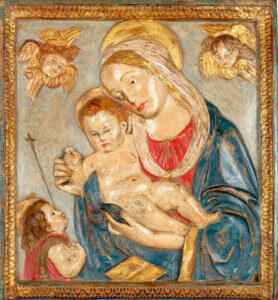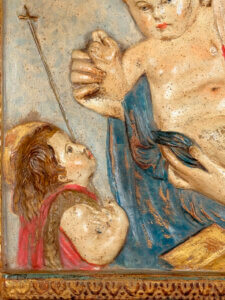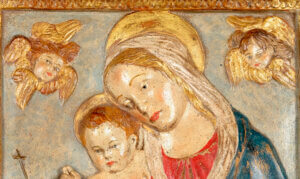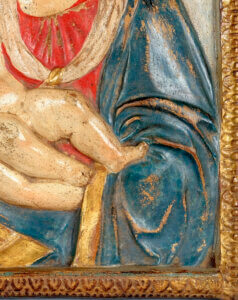Benedetto da Maiano was one of the main masters of Florentine Renaissance sculpture in the second half of the 15th century. He learned the sculptor’s trade from Antonio Rossellino (Settignano 1427 – 1479), who himself had studied under Donatello and was included in Giorgio Vasari’s Le vite de’ più eccellenti pittori, scultori, e architettori (1550). Da Maiano soon surpassed his master and produced important works in marble. However, clay was also one of his preferred materials.
Mary is depicted as a half-length figure holding the naked Christ child in her arms. Both look down at the childlike John the Baptist. In front of them lies an open book, probably the Holy Scriptures. The Madonna figure is flanked by two seraphim, each with three pairs of wings, which according to Christian tradition are closest to God. In terms of composition, da Maiano probably borrowed from Rossellino’s Madonna relief with angels from 1455-60 (MET, New York, inv. no. 14.40.675). The swirling winged angel heads and the hand gesture of the child’s right hand show striking parallels.
Florentine sculptors of this generation varied and refined the format of the popular Madonna motif. This composition is considered an important part of da Maiano’s late work. The oblique three-quarter view of Mary and the turning body of the infant Jesus in a relaxed posture show a further development from earlier, still rather rigid portraits. This can also be seen in a marble relief by da Maiano (MET, New York, inv. no. 41.190.137), where the child moves more vividly in the pictorial space and the sculptural handling of the drapery enables the depiction of more animated surfaces. In the relief of the MET, Jesus pulls on the mother’s veil and brings it together in front of her breast. In the relief presented here, the veil is tied together in a similar manner, but the focus is different, namely on the Baptist with the cross staff and camel hair fur. The open book could indicate a teaching function. Jesus has raised his right arm, supported by Mary’s hand, and is pointing his fingers in a gesture of speaking or blessing. John receives this blessing reverently and seems to take on the role of the founder. In doing so, he establishes a visual relationship with Mary, who acts as an intercessor; Jesus himself looks obliquely downwards, but still rapturously into the distance. The flanking angel heads elevate the depiction into the divine sphere.
The Madonna portraits in the Capuchin Museum in Florence, the Palazzo del Comune in Pistoia and the Museo Civico in Prato, which are versions of the same marble relief made around 1490 and now lost, are closely related in terms of composition. It is known that the da Maiano workshop executed this composition several times in stucco and terracotta. The depiction was extremely popular and can be found in numerous important museums, such as the Victoria & Albert Museum in London (inv. no. 5-1890; inv. no. V&A: 860-1891), the Museum of Fine Arts in Budapest (inv. no. 84.22) and the Hermitage in St. Petersburg. However, the relief presented here is captivating due to the high-quality execution of the hand-modeled surface structures, for example in the mannerist drapery of Mary’s cloak and in the harmoniously luminous polychromy with the finest craquelure, evident in the soft incarnate.
Literature:
Doris Carl, Benedetto da Maiano. A Florentine sculptor on the threshold of the High Renaissance, Regensburg 2005.
LINKS:
Da Maiano: https://www.metmuseum.org/art/collection/search/198952
Rossellino: https://www.metmuseum.org/art/collection/search/192716?pos=1
Terracotta copy: https://collections.vam.ac.uk/item/O93895/virgin-and-child-with-the-relief-da-maiano-benedetto/
https://collections.vam.ac.uk/item/O68927/virgin–child-with-the-relief/
Cf.



